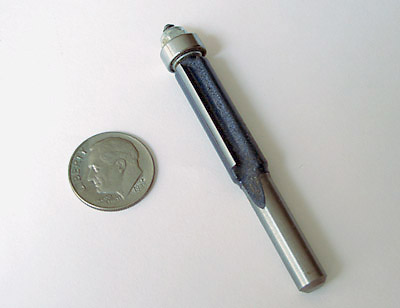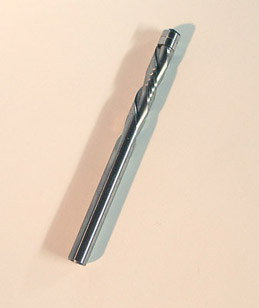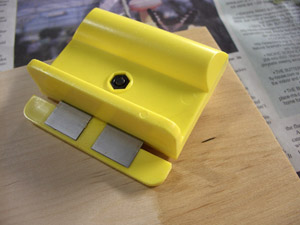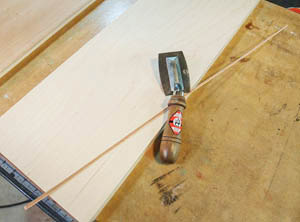

Veneer trimming options...
Through experiment I found the straight trimming router bits to work best for my needs. I also tried a down-cut spiral, but found that it left the veneer's paper backing glued to the side of the box.
 |
 |
| This style trimming bit worked best in my experiments. | I tried this spiral down-cut router bit, but it pushed the paper backing against the side of the box and heat from friction glued it there. |
There are other methods suggested for veneer trimming including the Band-it edge trimmer from Parts Express (and similar products sold elsewhere). They consist of plastic bodies with a replaceable blade to trim the veneer. While the cut is simple going with the direction of the grain, I found that it didn't cut easily going against the grain. It required lots of pressure, and guiding it accurately along the edge became difficult. On my first experiment, it gouged the side of the test material when it went slightly off-course. Admittedly I may not have mastered the proper technique, but I abandoned this approach without further experiments. It should work very well with thin sheets of vinyl coverings, etc. that are thinner and don't have grain.
 |
I bought this edge trimmer from Woodcraft. It looks similar, if not identical, to the Band It edge trimmer from Parts Express. |
Another Parts Express Tech Talk user suggested using a Veritas Flush plane to trim the excess veneer. The picture below came from Lee Valley Tools where this tool is sold. I haven't tried it, but it looks well made. The user who suggested it is an experienced builder and it works well for him.
 |
The Veritas Flush Plane was suggested by an experienced builder on the Parts Express Tech Talk forum. It's one idea that I didn't try myself. |
Finally, here's a method that I just tried again for the second time. I used a freshly sharpened veneer saw to trim the overhang. A veneer saw is actually a serrated knife with one side honed to be as flat as possible. It's important to note that I did NOT use this method on a cabinet, but on flat pieces of Baltic birch plywood where I didn't have to be concerned about marring a finished side. There are ways to prevent marring (i.e. insert a piece of cardboard between the veneer saw and the cabinet) that should make it workable though. The excess overhang could be sanded off.
 |
A
German-made veneer saw, freshly-sharpened on waterstones, cut
through the paperbacked veneer in about 4-5 cutting passes with
the grain, and in about 10-15 passes across the grain. Veneer saws must be sharpened to a razor's edge before use regardless of how sharp the manufacturer claims they are. I worked up through various grits of waterstones like I do to sharpen hand plane blades. If you follow the links above, they will take your to Joe Woodworker's site where I purchased the saw, and learned about sharpening it. |
Regardless of which trimmer you choose, I believe that you should leave a little bit of veneer edge to gently sand away to get the best edge.